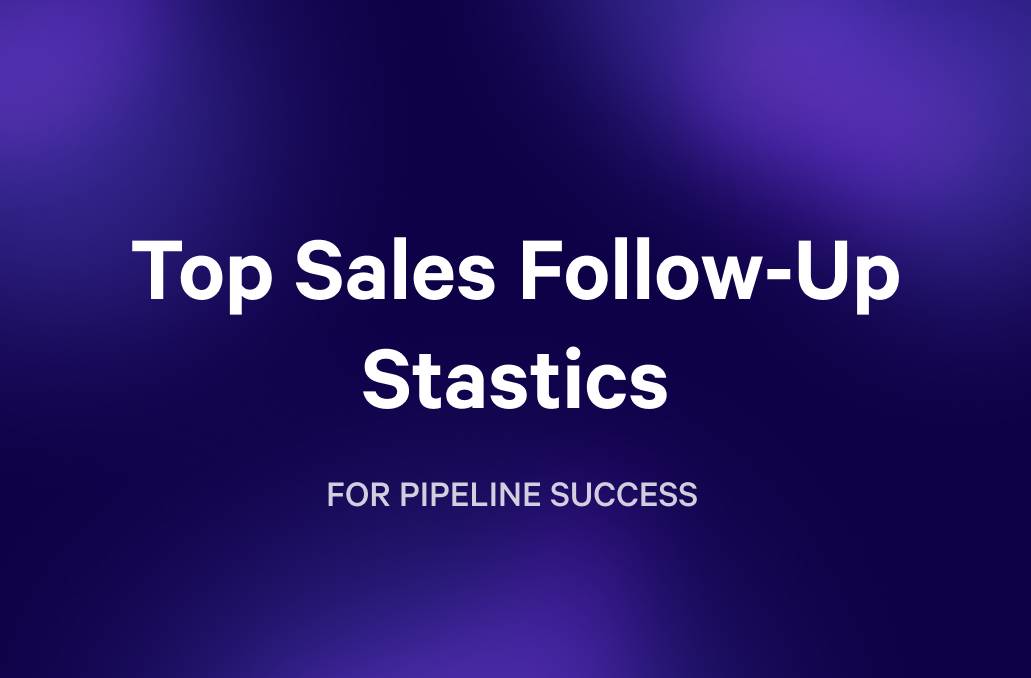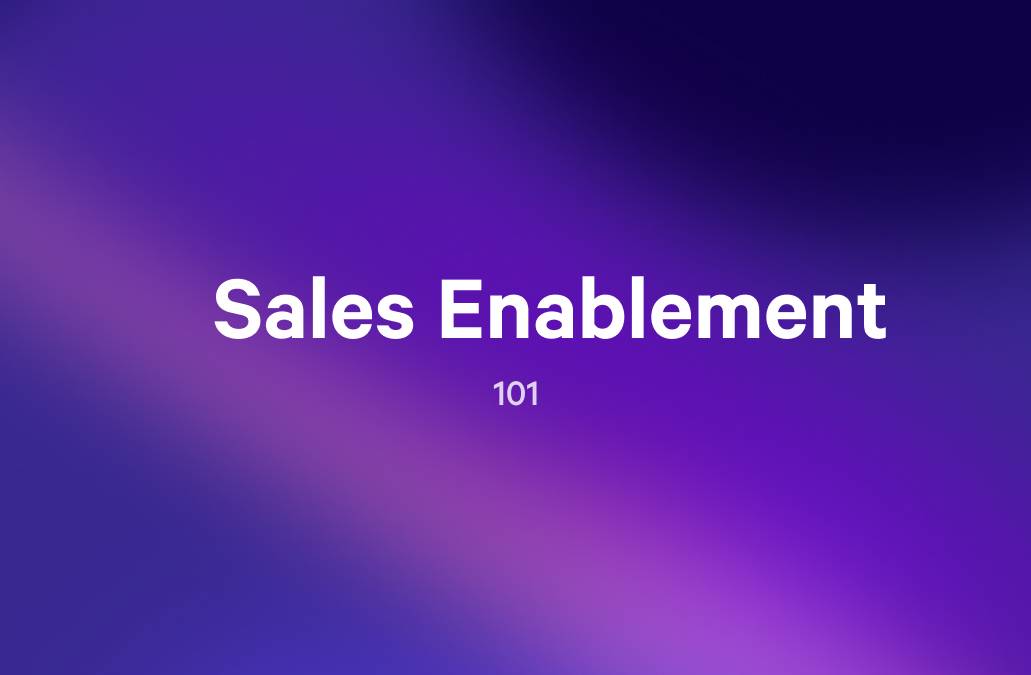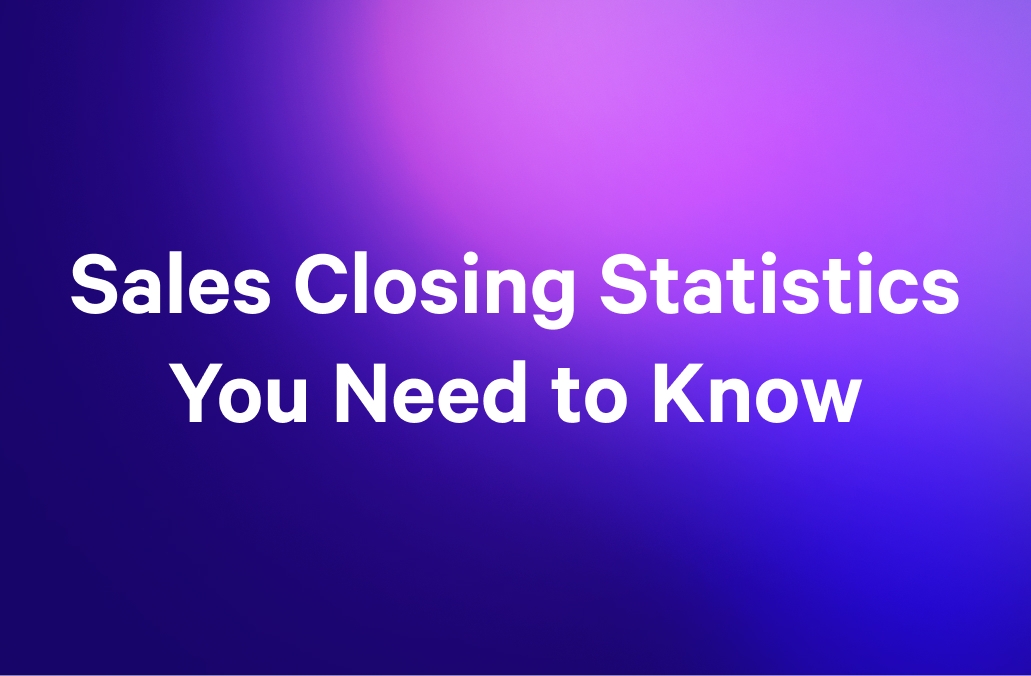In the ever-evolving world of sales, staying informed with the latest statistics is crucial for driving success and staying ahead of the curve. This comprehensive compilation of sales statistics delves into various facets of the sales process, from prospecting and lead nurturing to sales technology and performance metrics.
By exploring these key insights, sales leaders, reps and RevOps professionals can gain a deeper understanding of the current landscape, identify emerging trends, and develop strategies to optimize their sales efforts for maximum impact.
Whether you're looking to enhance your sales approach or simply stay informed, this collection of statistics offers valuable perspectives to guide your journey in the dynamic world of sales.
📌 Qwilr Tip: Use the right-hand side table of contents to navigate this round-up of sales statistics. We recognize there's a lot!
1. Sales Prospecting
Email Communication
🗞️ Headline statistic:
Only 23% of sales emails are opened. (Topo)
🤔 What does this mean?
This statistic underscores the importance of persistence and follow-up in sales email strategies. Given the low open rate, sales professionals must be resilient and consistently follow up with prospects to increase their chances of getting noticed and ultimately closing a deal.
- Email is the preferred communication method for 8 in 10 prospects. (Spotio)
- Personalized emails achieve an open rate of 29% and a click-through rate of 41%. (Campaign Monitor)
- Using the words “Sale,” “New,” or “Video” in subject lines boost open rates. (Adestra)
- The subject line word count with the highest open rate is seven words at 46.2%. (Regie.ai)
- The outbound email body copy word count with the highest reply rate is 144 words at 2.7%. (Regie.ai)
- Email is 40 times more effective at getting new customers than Facebook and Twitter combined. (McKinsey)
- AI-supported email marketing outperforms traditional methods, with 51% of respondents believing in its effectiveness. (Statista)
Social Selling
🗞️ Headline statistic:
78% of sales reps engaged in social selling outsell their peers. (Sprout Social)
🤔 What does this mean?
This statistic highlights the effectiveness of social selling as a strategy in the modern sales landscape. Sales reps who leverage social media platforms to connect with prospects and build relationships are more likely to outperform their peers who do not, emphasizing the importance of incorporating social selling into sales tactics.
- 75% of B2B buyers use social media to make purchasing decisions.
- Using social selling tools can increase the average deal size by 35%.
- 45% of sellers use LinkedIn for business purposes. (LinkedIn)
- By 2025, 80% of B2B sales interactions between suppliers and buyers will occur through digital channels. (Gartner)
Here's a list of the best B2B sales tools that can help. - 95% of sales reps admit they could improve their approach to social selling. (Sales for Life)
- 72% of salespeople who use social media in their sales process outperform their peers. (Jim Keenan Study)
- Social sellers hit their quotas 66% more often than those who don’t use social media. (Sales Benchmark Index)
- 54% of salespeople can track closed deals back to social media engagement. (Jim Keenan Study)
- Video is king. Posts with videos can generate engagement rates of 50% or more. (Databox)
- 96% of consumers want more contact with industry leaders. They often seek it through Twitter. (Databox)
- 98% of sales reps who have at least 5,000 LinkedIn contacts consistently reach or surpass their sales quotas.
Cold Calling
🗞️ Headline statistic:
Only 28% of sales reps find cold calling effective. (Rain Group)
🤔 What does this mean?
This statistic indicates that a significant majority of sales reps do not consider cold calling to be an effective sales strategy. The low success rate suggests that alternative methods of prospecting, such as social selling or inbound marketing, may be more efficient in generating leads and closing deals in today's market.
- Only 2% of cold calls result in an appointment. (Leap Job)
- It takes an average of 8 attempts to reach a prospect today. (Spotio)
- 85% of prospects and customers are dissatisfied with their on-the-phone experience. (Spotio)
- The average inside sales rep can make 33 cold calls per day. (ForEntrepreneurs and The Bridge Group)
- About 72% of all cold calls don’t get through to a human being. (Baylor University)
- The average sales pro will spend 7.5 hours cold-calling to secure one appointment or referral. (Baylor University)
- 41.2% of sales reps say that their phone is the most effective tool for performing their jobs. (Sales Insights Lab)
- Sales reps spend about 15% of their time leaving voicemails. (Ringlead)
- The average sales rep makes 52 calls every day. (The Bridge Group)
- You are 15% more likely to connect with your prospect between 8-11 am their time. (Xant)
- 88% of sellers engage in warm calls; just 46% say they conduct cold calls. (LinkedIn)
- 57% of C-Level and VP-level buyers prefer to connect with sellers on the phone. (Rain Group)
Social Selling
🗞️ Headline statistic:
96% of prospects do their own research before speaking with a human sales rep. (HubSpot)
🤔 What does this mean?
This statistic highlights the importance of a strong online presence and valuable content for businesses. Since the majority of prospects conduct their own research before engaging with a sales representative, it's crucial for companies to provide easily accessible and informative resources that can guide potential customers through their buying journey and establish trust before direct contact is made.
- 71% of prospects prefer to do solo research instead of talking to a person. (HubSpot)
- 42% of salespeople consider prospecting the most challenging part of the sales process. (HubSpot)
- 71% of buyers want to hear from reps when they're looking for ideas to drive stronger business results. (RAIN Group)
- It takes an average of 8 touches to set up a meeting or other conversions with a new prospect. (Crunchbase)
- Top salespeople spend an average of 5 hours per week on prospecting activities. (Crunchbase)
- 89.9% of companies use two or more sources of contact data to meet their sales development needs. (Gartner)
- 80% of prospects prefer talking to reps over email, while 50% prefer talking over the phone. (Notta)
- 56% of sales professionals use social media to find new prospects. (Notta)
- The biggest factors in whether a prospect connects with a rep are Need for their product or service - 75%, Having a budget - 64%, The rep’s offer to provide something of value - 63%. (Notta)
2. Sales Process
Social Selling
🗞️ Headline statistic:
92% of salespeople give up after four “no’s”, but 80% of prospects say “no” four times before they say “yes”. (Marketing Donut)
🤔 What does this mean?
This statistic underscores the significance of perseverance and resilience in the sales process. Despite the high percentage of salespeople who give up after receiving a few rejections, the data suggests that persistence pays off, as a majority of prospects tend to decline several times before finally agreeing to a sale. Therefore, sales professionals should adopt a tenacious approach, continuing to follow up and engage with potential clients even after initial rejections, to increase their chances of success.
- Calling a lead in the first 5 minutes after they've submitted a web form makes them 100 times more likely to get on the phone. (Inside Sales)
- 70% of salespeople stop at one email. (Invesp)
- 80% of sales require 5 follow-up calls after the meeting. (Spotio)
- 50% of buyers choose the vendor that responds first. (Spotio)
- 60% of customers say no four times before saying yes. (Invesp)
- 80% of sales require five follow-up calls. (Invesp)
- But 48% of salespeople never even make a single follow-up attempt. (Invesp)
- 44% of salespeople give up after one follow-up call. (Invesp)
- 66% of buyers prefer to be contacted via email. (LinkedIn)
- The first follow-up email is very effective and can boost the reply rate by 49%. (Belkins)
- The optimal time to wait before following up on a cold email is 2–5 days. (Belkins)
- Cold email outreach campaigns with three email rounds tend to have the highest reply rates (9.2%). (Belkins)
- On average, it takes 8 follow-up calls to reach a prospect. (Telenet and Ovation Sales Group)
Lead Nurturing
🗞️ Headline statistic:
Companies excelling at lead nurturing generate 50% more sales-ready leads at 33% lower cost. (Forrester Research)
🤔 What does this mean?
This statistic emphasizes the value of effective lead nurturing in the sales process. It indicates that companies that excel in maintaining and developing relationships with potential clients are not only able to increase the number of leads ready for sales but also do so at a significantly lower cost. This highlights the importance of implementing strategic lead nurturing practices to optimize the sales pipeline and achieve cost-efficient results.
- 74% of companies say converting leads into customers is their top priority. (HubSpot)
- Nurtured leads produce a 20% increase in sales opportunities. (DemandGen Report)
- Best-in-class companies close 30% of sales qualified leads. (Spotio)
Lead Qualification
🗞️ Headline statistic:
46% of B2B sales reps list lead quantity and quality as their top challenge. (Spotio)
🤔 What does this mean?
This statistic highlights a common challenge faced by B2B sales representatives: balancing the quantity and quality of leads. Nearly half of sales reps struggle with either having enough leads to work with or ensuring that the leads they do have are of high quality and likely to convert into sales. This underscores the importance of effective lead generation and qualification strategies in the B2B sales process to ensure that reps have a sufficient number of promising leads to pursue.
- 67% of lost sales are due to improper lead qualification. (Spotio)
- Only 25% of marketing-generated leads are of high enough quality to advance to sales. (Gleanster Research)
3. Sales Teams
Inbound Sales
🗞️ Headline statistic:
59% of marketing professionals say inbound marketing generates high-quality leads, compared to 16% who report that outbound marketing does. At the same time, inbound marketing leads cost 61% less to generate than outbound leads. (HubSpot)
🤔 What does this mean?
These statistics highlight the effectiveness and efficiency of inbound marketing. A majority of marketers find it superior for generating high-quality leads at a significantly lower cost compared to outbound strategies. This emphasizes the strategic advantage of adopting inbound tactics for better ROI and cost-effective lead generation.
- Inside sales is growing rapidly, with significant cost advantages over outside sales. (PointClear)
- Marketing contributes 44% to the inside sales pipeline, but average dials are down 20% year-over-year. (Bridge Group Inc)
- High-growth companies often use inside sales as their primary strategy. (Pacific Crest)
- Only 33% of a rep's time is spent actively selling. (CSO Insights)
- Speed is crucial, with 35% to 50% of sales going to the vendor that responds first. (InsideSales.com)
- 46% of marketers reported that inbound marketing gave a higher ROI.
- 93% of B2B buying processes begin with an online search.
- 47% of buyers view 3-5 pieces of a company's content before talking with a sales representative.
- 47% of purchasers view three to five pieces of a company’s content before speaking with a sales representative. (HubSpot)
- 46% of marketing professionals say that inbound marketing has a higher ROI, while only 12% say that outbound does. (HubSpot)
- 64% of sales teams that use inbound social selling reach their quotas, compared to 49% who do not. (Aberdeen Group)
- A whopping 93% of B2B purchase processes start with an online search, and 94% of B2B buyers research online before finalizing a purchase.
- 98% of sales reps who have at least 5,000 LinkedIn contacts consistently reach or surpass their sales quotas.
Outbound Sales
🗞️ Headline statistic:
Outside sales reps have a 40% close rate on average, higher than inside sales. (Zety)
🤔 What does this mean?
This statistic highlights the effectiveness of outside sales in handling larger accounts that have a greater need or inclination to purchase. The 40% close rate suggests that outside sales reps are more successful in securing deals, likely due to their focus on bigger clients with more substantial buying potential.
- Field sales teams make up 71.2% of the sales force.
- 65% of outside account executives are attaining quota, 10% higher than inside reps.
- Remote selling time has increased by 89% since 2013. As a result, remote sales tools have become more popular.
- 46% of fast-growing tech companies employ inside sales, while 21% use outside sales. (Zippia)
- Acquiring new customers costs outside sales teams 40% to 90% more than it costs inside sales teams. (ZS Associates)
- Inside calls cost an average of $50, while outside calls cost an average of $308. (Pointclear)
- The average outside sales call will cost $308. Meanwhile, the average inside sales call costs $50. (Pointclear)
3. Customer Interaction
Decision Making
🗞️ Headline statistic:
In a typical firm with 100-500 employees, an average of 7 people are involved in buying decisions (Gartner Group). At the same time, B2B buyers are 57%-70% through buying research before contacting sales. (Spotio)
🤔 What does this mean?
These two statistics underscore the complexity of the B2B buying process, where multiple stakeholders are involved in decision-making. It also highlights the importance of a well-informed sales approach, as buyers are already more than halfway through their research before they even engage with a sales representative. To be effective, sales professionals must be prepared to address the needs and concerns of various decision-makers and offer insights that add value to the buyer's research.
- The businesses’ buying process will involve around 6-10 decision-makers. (Outreach)
- Trustworthiness (47%) and responsiveness (44%) are the two most important characteristics buyers look for in a sales professional. (LinkedIn)
- 46% of buyers agree that “active listening” is the number one skill they expect from sales professionals; meanwhile, managers rank “active listening” as the seventh skill they look for in an applicant. (LinkedIn)
Customer Engagement
🗞️ Headline statistic:
82% of sales pros say that building relationships with people is the most important part of selling. (HubSpot)
🤔 What does this mean?
This statistic emphasizes the critical role of relationship-building in the sales process. It suggests that sales professionals who prioritize establishing trust and rapport with their clients are more likely to succeed. Building strong relationships not only helps in understanding the needs and challenges of the customer but also fosters loyalty and long-term partnerships, which are key to achieving sales success.
- 92% of all customer interactions happen over the phone. (Salesforce)
- 84% of consumers cite good customer service as one of the key factors when buying from a brand. (Zendesk)
- Sales market research data reveals that 79% of consumers prefer interacting with salespeople who are trusted advisors that can add value to their business–not just sales representatives who are selling them products and services. (Salesforce)
- Companies with an effective VoC program can experience a 55% increase in customer retention. (Gainsight)
- 64% of shoppers are generally ok with vendors saving their purchase history and personal preferences for personalization purposes. (Customer Think)
- 62% of shoppers are more scared of their information being compromised now than they were two years ago. (Salesforce)
- 56% of consumers prefer to buy from companies that consistently release new products and services based on their needs and new technology. (Salesforce)
- 71% of consumers recommend a product or service because they received a positive experience. (HubSpot)
- Customers who have the best past experiences spend 140% more compared to those who have the poorest past experiences. (Harvard Business Review)
- Companies with the strongest omni-channel customer engagement strategies retain an average of 89% of their customers compared to 33% for companies with weak strategies. (Aberdeen Group)
- Retaining current customers is 6 to 7 times less costly than acquiring new ones, underscoring the importance of customer retention strategies. (The Brevet Group)
Referrals
🗞️ Headline statistic:
73% of executives prefer to work with sales professionals referred by someone they know. (IDC)
🤔 What does this mean?
This stat suggests that executives place a high value on trust and credibility, which are often established through personal connections or recommendations. Sales professionals who can leverage their network to gain referrals are more likely to gain access to decision-makers and build trust more quickly, leading to more successful sales outcomes.
- Companies with formalized referral programs experience 86% more revenue growth. (Wharton School of Business)
- Salespeople who actively seek out and exploit referrals earn 4 to 5 times more than those who don’t. (The Brevet Group)
- 91% of customers say they’d give referrals, but only 11% of salespeople ask for referrals. (The Brevet Group)
- 57.9% of reps say that they ask for fewer than one referral per month, 40.4% report rarely asking, and only 18.6% ask every person they are in front of. (Sales Insights Lab)
- 83% of customers are open to referring a business after a successful purchase. (Thinkimpact.com)
- Customers acquired through referrals have a 37% higher retention rate and are four times more likely to make a purchase.
- 92% of customers are willing to trust companies when referrals come from people they know. (Nielsen)
- 65% of a B2B company’s new sales are from referrals. (Thinkimpact.com)
- 78% of the B2B referrals create viable customer leads for the business.
4. Sales & Marketing
Sales and Marketing Alignment
🗞️ Headline statistic:
The biggest barriers to sales and marketing alignment, according to sales leaders, are:
- Lack of effective communication between the teams - 38%
- Lack of alignment on goals or strategies - 30%
- Lack of sales input on marketing content - 27%
- Use of different tools by the teams - 26%
- Difficulty in sharing data between the teams - 26%. (Notta)
🤔 What does this mean?
To improve alignment, it's crucial for both teams to work together to establish common objectives, share insights, and coordinate their efforts to drive better results and enhance overall business performance.
- Only 30% of sales pros say sales and marketing are strongly aligned at their company. (HubSpot)
- 85% of marketers say that supporting their sales team is their #1 priority. Still, 56% of salespeople must prepare their own sales materials. (Hubspot)
- One in five sales professionals believes that sales and marketing teams aren’t very aligned or not aligned at all. (Notta)
5. Sales Technology
CRM and Sales Tools
🗞️ Headline statistic:
78% of sales pros say their CRM is effective at improving sales and marketing alignment. (HubSpot)
🤔 What does this mean?
With 78% of sales professionals affirming their CRM's effectiveness in this area, it underscores the importance of leveraging technology to facilitate communication, share data, and coordinate strategies between departments. This alignment is crucial for a cohesive approach to customer engagement and achieving business goals.
- 57% of sales pros spend 3–10+ hours per week using CRM tools. (State of Sales, LinkedIn)
- CRMs can boost sales by 29% and productivity by 34%. (Salesforce)
- 69% of sales leaders are planning to invest in prospecting technology. (Prezentor)
- Half of sellers use CRM tools, 45% use sales intelligence, and 42% use sales planning tools. (LinkedIn)
- Top performers spend about 18% more time updating their CRM system than average performers do. (LinkedIn)
- 63% of sales professionals say that having access to the right technology is more important now compared to five years ago. (LinkedIn)
- The adoption rate of sales technologies among sales professionals has increased by 90% since 2015. (Salesforce)
- Sales professionals are expected to spend an average of 43% of their time on research and data entry tasks in CRM systems. (HubSpot)
- The top 3 types of sales technologies that companies are planning to use are analytics and reporting tools (79%), sales automation (74%), and CRM tools (71%). RFP management and sales proposal software is used by 49%. (HubSpot/Loopio)
- 52% of sales pros use sales enablement content, and 79% of them say it’s important to making a sale. (HubSpot)
- Companies that use sales enablement tools experience a 13.7% annual increase in deal size. (Aberdeen Group)
We've created a list of the best sales tools which you may find helpful.
AI in Sales
🗞️ Headline statistic:
High-performing sales professionals are more than 2x as likely to use AI to guide their selling. (Salesforce)
🤔 What does this mean?
By being more than twice as likely to utilize AI in their selling process, these top performers demonstrate the effectiveness of leveraging technology to enhance decision-making, personalize customer interactions, and streamline sales activities, ultimately leading to better results.
- 81% of sales leaders say that AI can help them spend less time on manual tasks. (HubSpot)
- 63% of sales leaders say AI makes it easier for them to compete with other businesses in their industry. (HubSpot)
- 66% of sales pros say AI helps them understand customers better and provide personalization. (HubSpot)
- 70% of sales professionals say using AI helps them save more time. Our AI proposal generator is an example of this.
- Customer service teams who used an AI-based conversational assistant increased the number of issues they resolved per hour by 14%.
- Companies can save up to $89.07 billion per year if sales professionals use AI to complete data entry and non-sales-related tasks.
- Businesses that used AI in their sales process reported a 50% increase in sales leads.
- More than 30% of sales-related activities can be automated with today’s technology. (McKinsey)
- 54% of sales professionals believe sales technology is a great resource for building stronger relationships with buyers. (Zendesk)
- 77% of salespeople say their company intends to invest more in sales intelligence tools. (Linkedin)
- Gartner predicts that by 2025, 75% of B2B companies will employ AI to elevate traditional sales books.
- 61% of sales high-performers use a CRM to automate parts of their sales process. (HubSpot)
- 54% of sales reps say digital sales tools help them win over more prospects. (Zendesk)
- 2 out of 3 organizations that use dedicated sales analytics tools said they have improved the results of their sales activities and processes significantly (20%) or slightly (47%).
- High-performing sales professionals are more than 2x as likely to use AI to guide their selling. (Salesforce)
You can also read our guide on the best AI sales tools as well as other sales automation software.
Sales Data Usage
🗞️ Headline statistic:
45% of sales professionals are overwhelmed by the amount of tools in their tech stack. (HubSpot)
🤔 What does this mean?
With nearly half of sales reps feeling inundated by the sheer number of tools they must navigate, it underscores the need for more streamlined, integrated solutions that can simplify workflows and enhance efficiency without adding to the cognitive burden of the sales team.
- 52% of sales pros say B2B customers use self-serve tools more than last year. (HubSpot)
- Sales pros who offer buyers self-service tools are 47% more likely to be over goal this year than those who don’t. (HubSpot)
- The use of sales enablement tools by sales pros in the United States increased by 20% in 2023. (HubSpot)
- 1 in 4 sales leaders say they have too many tools. (HubSpot)
- 29% of sales pros say that reducing their tech stack would make them more efficient. (HubSpot)
- 43% of sellers say that buyer intent data is “very important” to their sales processes. (LinkedIn)
- Top performers spend about 10% less time selling than average performers. (LinkedIn)
6. Sales Performance
Sales Productivity
🗞️ Headline statistic:
Sales reps spend only a third of their productive hours talking to prospects. The rest of their day is allocated to:
- Writing emails (21%)
- Entering data (17%)
- Researching leads (17%)
- Team meetings (12%)
- Scheduling calls (12%)
- Training (11%)
- Reading up on industry reports (11%) (HubSpot)
🤔 What does this mean?
This statistic reveals a significant inefficiency in sales reps' workdays, with only a third of their time spent on direct prospect interaction. The majority of their hours are consumed by administrative tasks, lead research, and internal meetings. This distribution suggests a need for better time management strategies and tools that can automate routine tasks, allowing sales professionals to focus more on engaging with potential clients and driving sales.
- It takes 10 months or more for a new sales rep to be fully productive. (Spotio)
- 79% of sales executives say improving the productivity of existing sales reps is a leading driver of hitting new targets. (Spotio)
- Lost productivity and poorly managed leads cost companies at least $1 trillion every year. (Marketo)
- 71% of sales reps say they spend too much time on data entry. (Toutapp)
- 42.5% of sales reps take 10 months or longer to become productive enough to contribute to company goals. (IRC)
- High-performing companies are 2 times as likely as underperforming companies to describe their sales processes as automated. (Velocify)
- Only 35.2% of a sales rep's time is spent actively selling. (Forbes)
- Sales reps who use social selling are 50% more likely to meet or exceed their quota. (LinkedIn)
- Only 46.7% of sales reps globally meet quota. (Sales Hacker)
- 41.1% of sales professionals say they consider their phones their most productive sales tool. (Notta)
- 81% of companies believe that productivity would improve with better processes, skills, or competency training. (Notta)
- Top-performing sales representatives “pitch” their offer only 7% of the time. (Notta)
- Top-performing sales reps only talk about product features 9% of the time in discovery calls and 19% of the time in presentations, while other reps talk about the product 18% of the time in discovery calls and 31% of the time in presentations. (Notta)
- The discovery calls of top-performing reps are 76% longer than that of the average salesperson. Their presentation calls are also 55% longer. (Notta)
- 81% of sales and marketing teams do not review and correct their sales processes. (Notta)
- The average new hire is fully productive in 5.3 months, 24% are ready in 1–3 months, and 16% take longer than seven months. (Notta)
- Salespeople spend 66% of their day on administrative tasks. (Hubspot)
We've also posted a guide about our top-rated sales productivity tools.
Sales Training
🗞️ Headline statistic:
Sales training can boost an individual rep's sales performance by an average of 20%. (Salesforce Training). However, at the same time, 84% of all sales training is lost after 90 days due to lack of information retention. (Spotio)
🤔 What does this mean?
This statistic highlights the potential impact of sales training on individual performance, with a significant average boost of 20%. However, it also underscores a major challenge: the rapid decline in retention of training material, with 84% of the knowledge being lost within just 90 days. This suggests that while training is crucial, it needs to be reinforced regularly and supported by ongoing learning and development initiatives to ensure lasting benefits.
- 55% of salespeople lack basic sales skills. (Forbes)
- Firms where salespeople use the company’s methodology and get consistent coaching see 73% quota attainment. (Spotio)
- The average company spends $2,000+ annually on training for each sales rep. (HighSpot)
- The ROI of sales training is 353%, with $1 spent training your reps producing $4.53 in return. (TaskDrive)
- When salespeople use their company's sales methodology and receive consistent training, they attain quota 73% of the time. (Spoti)
- 65% of employees claim that quality sales training positively influences their engagement. (Spotio)
- 59% of companies say the biggest obstacle to effective sales training is accountability. (BrainShark)
- Sales leaders who teach their reps to open cold calls with the question, "How've you been?" see rep success rates jump by 6.6%. (Gong)
- Over 50% of sales training is forgotten within 5 weeks. (Sales Insights Lab)
- 48% of sales professionals believe that their organization does not have the necessary sales training. (Richardson Sales Performance)
- Nearly 60% of companies believe that they are ineffective at sales training. (Sales Insights Lab)
- 77% of companies do not train or have a formalized sales onboarding process. (Sales Insights Lab)
- 69% of employees are more likely to stay with a company for three years if they experienced great onboarding. (Glassdoor)
Sales Career
🗞️ Headline statistic:
The Bureau of Labor Statistics projects 6% employment growth for sales representatives by 2026. (Spotio)
🤔 What does this mean?
This statistic indicates a positive outlook for the sales profession, with a projected employment growth of 6% by 2026. This growth suggests an increasing demand for sales representatives, highlighting the importance of the sales function in business and the opportunities available for individuals considering a career in sales.
- The median OTE for an:
- SDR is $76,000.
- SDR Manager is $128,000.
- B2B AE is $132,000.
- AE Manager is $156,000.
- Director of Sales Development is $177,000.
- Director AE is $218,000.
- Only 39% of salespeople intended to go into sales. (Spotio)
- The typical account executive spends 2.7 years on the job and takes 4.7 months to ramp. (Spotio)
Sales Success
🗞️ Headline statistic:
The most successful salespeople have aligned their personal goals with work goals. (Harvard Business Review)
🤔 What does this mean?
Salespeople who align their personal ambitions with their work objectives tend to achieve higher levels of success, as this alignment fosters a sense of purpose and motivation, leading to better performance and job satisfaction.
- Successful reps are 10x more likely to use collaborative words like “us,” “we,” and “our”. (Spotio)
- Tools for success. 75%–85% of top salespeople value CRMs, sales productivity apps, email marketing, and social selling as key factors in their success. (State of Sales, LinkedIn)
- Curiosity, intelligence, and an agile mind are the biggest predictors of sales success. (Harvard Business Review)
- The average sales win rate is 21%. (HubSpot)
- The average sales close rate is 29%. (HubSpot)
- 91% of sales pros upsell, and they say it brings in an average of 21% of company revenue. (HubSpot)
- 87% of sales pros cross-sell, and they say it brings in an average of 21% of company revenue. (HubSpot)
- 81.2% of respondents believed that an inability to offer flexible payment options hindered deals from closing. (Capchase)
- 42% of companies reported a decrease in win rates over the last 12 months, with 30% of those companies experiencing a decline of over 11%. (Lightspeed)
This will be a particularly alarming statistic for startups. We've listed out our favorite sales tools for startups that can help turn this downward trend around.
7. Sales Management
Sales Strategy
🗞️ Headline statistic:
Over 50% of successful sales teams have a 12-month view of their plans while 10% map out the next three years. (McKinsey & Company)
🤔 What does this mean?
Successful sales teams are more likely to have a clear vision of their goals and strategies for at least the next year, with some even planning up to three years ahead, indicating that foresight and proactive planning are key components of sales effectiveness.
- 62% of sales pros say their organization is taking fewer risks in 2023 than in 2022. (HubSpot)
- 70% of sales pros say budgets are more scrutinized in 2023 than in 2022. (HubSpot)
- 28% of sales pros say the sales process taking too long is the biggest reason prospects back out of deals. (HubSpot)
- 72% of company revenue comes from existing customers, with 28% coming from new customers. (HubSpot)
- 24% of high-performing sales teams highly rank the importance of building a culture of trust among reps. Only 13% of underperforming sales teams have done the same. (HubSpot)
- The average company loses between 10% and 30% of its customers each year, emphasizing the need for continuous prospecting even when the pipeline is full. (The Brevet Group)
Sales Training, Coaching and Content
🗞️ Headline statistic:
47% of AEs have left a sales job due to a lack of training or a poor onboarding experience (Qwilr)
🤔 What does this mean?
Nearly half of AEs have left their positions due to inadequate training or poor onboarding experiences, highlighting the need for organizations to invest in comprehensive training programs and structured onboarding processes to retain top sales talent.
- Sales cycles increased for 53% of companies. (Lightspeed)
- 48% of sellers say they struggle with communicating value. (Prezentor)
- 40% of sales teams face long onboarding times. (Prezentor)
- Continuous training gives 50% higher net sales per employee, highlighting the importance of ongoing development for sales teams. (The Brevet Group)
- Organizations with a standard sales process experience 18% more revenue growth compared to organizations without one. (CSO Insights)
- Companies with a defined sales process see 18% more revenue growth than those without. (Hubspot)
- 96% of sales leaders agree that effective sales coaching positively impacts their salespeople’s performance. (Notta)
- The average company spends $10K - $15K hiring an individual and only $2K a year in sales training, suggesting a gap in investment in training for new salespeople. (The Brevet Group)
- 38% of sales managers have selling skills as the number one area of focus when coaching their reps. (Notta)
- Sales coaching can improve sales performance by 20% (DePaul University)
- 72% of sales leaders recognize that they need to upskill their sales teams. (Notta)
- 84% of buyers say that being treated like a person, not a number, is very important to winning their business. (Salesforce)
- 55% of people making their living in sales don’t have the right skills to be successful, indicating a need for better training and development programs in sales organizations. (The Brevet Group)
Sales Enablement and Content
🗞️ Headline statistic:
Companies with a dedicated sales enablement person or team have 15% better win rates. (Hubspot)
🤔 What does this mean?
This statistic highlights the significant impact of having a dedicated sales enablement team on a company's sales success. Companies that invest in specialized sales enablement personnel or teams experience a 15% higher win rate compared to those without, emphasizing the value of targeted support and resources in enhancing sales performance.
- Companies with effective sales enablement programs experience a 13.7% annual increase in deal size. (HubSpot)
- Sales reps spend only 37% of their time selling. (CSO Insights)
- 70% of sales content created by marketing is never used by sales. (SiriusDecisions)
- 61% of organizations say that selling is more difficult than it was five years ago. (Hubspot)
- 74% of organizations admit that their sales enablement programs are ineffective. (CSO Insights)
- 76% of sales leaders are planning to invest in content creation. (Prezentor)
- 65% of sales content created by B2B organizations goes unused. (Prezentor)
- 95% of B2B buying decisions are directly influenced by content. (Prezentor)
You can use the best b2b marketing tools to help with this process. - Only 46% of sales reps have access to the right content to send to prospects. (CSO Insights)
- 62% of organizations do not have a clear strategy for sales enablement. (CSO Insights)
Qwilr's proposal templates make creating effective and engaging sales content a breeze.
You can also read our guide on the best sales enablement software.
Sales Team Management
🗞️ Headline statistic:
65% of reps believe the training quality and learning opportunities their company offers positively influence their engagement. (Notta)
🤔 What does this mean?
A majority of reps believe that the quality of training and learning opportunities provided by their company has a positive impact on their engagement, highlighting the need for companies to invest in effective training programs to enhance rep engagement and performance.
- Sales managers spend 32% of their time managing people, 26% of their time managing information, 23% of their time on customer interaction, 15% of their time on administrative tasks, and 4% of their time is spent on control (eating lunch, etc.). (Notta)
- Poor sales management can cost a company up to $3.5 million annually. (Notta)
- In addition to overseeing their teams, 74% of sales managers handle their own sales accounts. (Notta)
- Investing in training salespeople has a 353% ROI. (Notta)
- 70% of US-based sales managers agreed that managers’ capability to adapt to change is more important now compared to five years ago. (LinkedIn)
Sales Challenges
🗞️ Headline statistic:
Among the top challenges in sales include:
- The disconnect between sales managers and sales professionals
- Relationship management and quota attainment
- The usefulness of CRM tools. (Richardson Sales Performance)
🤔 What does this mean?
This statement highlights key challenges faced by sales professionals. Addressing these challenges is crucial for improving sales performance and ensuring a cohesive and productive sales environment.
- There’s an average of five decision-makers involved in every sales process today. (HubSpot)
- 28% of sales pros say the sales process taking too long is the biggest reason prospects back out of deals. (HubSpot)
- 24% of high-performing sales teams highly rank the importance of building a culture of trust among reps. Only 13% of underperforming sales teams have done the same. (HubSpot)
- Only 30% of sales pros say sales and marketing are strongly aligned at their company. (HubSpot)
- 77% of sales professionals conduct virtual meetings; 57% use their phone more; while 51% use emails to respond to customers. (LinkedIn)
References
Interested in more topic-specific deep dives?
We've got a growing number of sales statistics articles to set you up for success:
- Sales coaching statistics
- Sales training statistics
- Sales enablement statistics
- Sales follow up statistics
Final thoughts
The statistics presented in this blog post, alongside the advancements in proposal software, offer a 360-degree view of the current sales landscape. From the effectiveness of email communication and social selling to the challenges of sales training and team management, these insights provide a roadmap for sales professionals to optimize their strategies and enhance their performance. Leveraging proposal software can address some of the key challenges highlighted by these statistics, streamlining the proposal creation process and enabling sales teams to deliver personalized and compelling content to their prospects efficiently.
By understanding and applying these key statistics, sales teams can better navigate the complexities of their roles, build stronger relationships with customers, and drive success in an ever-evolving market.
About the author

Brendan Connaughton|Head of Growth Marketing
Brendan heads up growth marketing and demand generation at Qwilr, overseeing performance marketing, SEO, and lifecycle initiatives. Brendan has been instrumental in developing go-to-market functions for a number of high-growth startups and challenger brands.
Frequently asked questions
Persistence is crucial in sales follow-up as it separates successful reps from unsuccessful ones. Just 2% of sales occur on the first contact, and 80% of sales need between 5 to 12 contact attempts before closing. Therefore, persistence is essential.
The timing of your follow-up can significantly impact your success. Engaging leads within 60 seconds of inquiry can boost conversion rates by almost 400%. Also, early mornings and late afternoons are prime times for making successful cold calls.
Technology, especially AI, can enhance follow-up strategies by analyzing lead behavior, predicting ideal contact times, and automating repetitive tasks. 55% of C-suite leaders identify sales enablement tools as their companies' most important technology investment.
Securing a conversion typically requires between 5 to 8 follow-up touches. High-growth organizations use up to 16 touchpoints over a 2-4 week span, balancing persistence with tact to avoid overwhelming prospects.
Integrating video into follow-up strategies can enhance engagement and conversion rates. Personalization in email follow-ups, like using a friendly greeting, can positively impact open rates by up to 41%.








